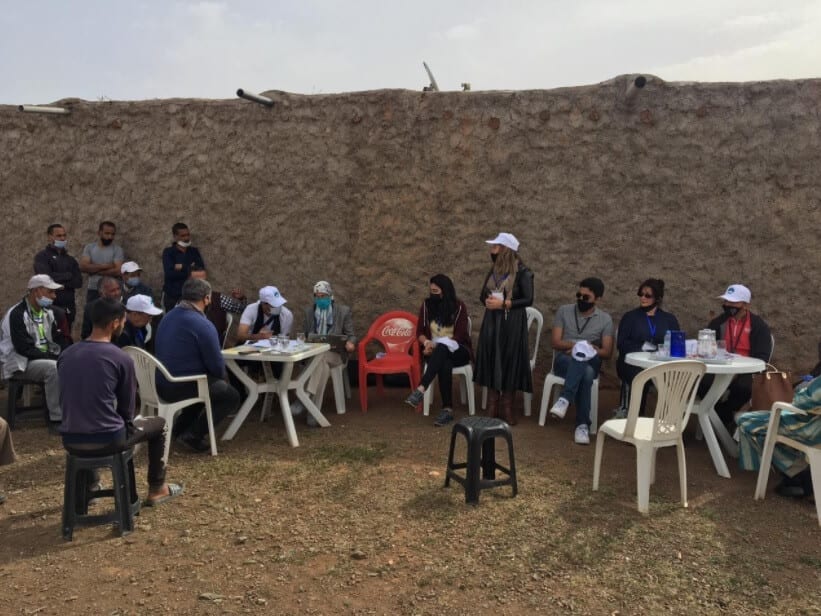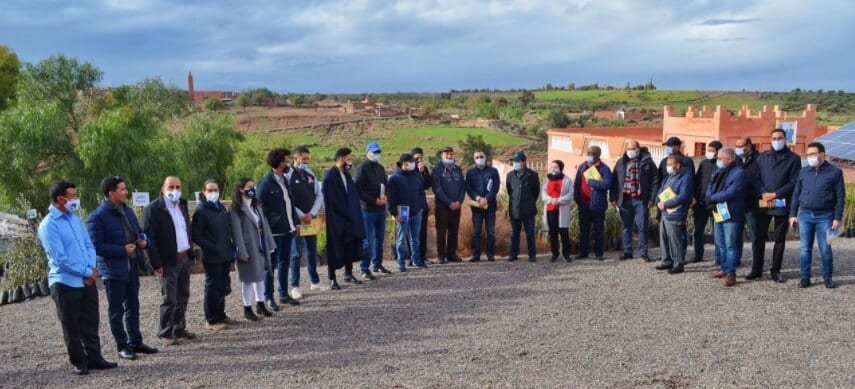Why Morocco Must Address Climate Change’s Threats to Water Resources, Morocco World News, By Megan Williams and Megan Sprotte HAF-UVA Interns.
Megan Sprotte and Megan Williams
HAF-UVA Interns

Climate change is impacting water resources in Morocco, creating aggravated conditions as a result of both the environmental characteristics and social vulnerability that are present in the region. As the average global temperature of Earth continues to increase, there will be wide effects on a number of climatic variables, including the frequency of precipitation and quality of water resources. Morocco’s water supply is rated as extremely high stress by the World Resources Institute because more than 80% of the available water is withdrawn annually for agricultural, domestic and industrial use1, and in addition to this, the ratio of renewable water resources to the population is less than 1000m³ per year2. Water stress occurs when demand for water exceeds the available amount, or when poor quality restricts its use3. This causes deterioration of fresh water resources in quantity such as aquifer overexploitation and dry rivers, as well as in quality such as toxic algal blooms and undesirably high levels of salt due to saltwater intrusion. Such deterioration can result in health problems and have a harmful influence on ecosystems and communities4.
Furthering this problem, several studies on the north-eastern region of Morocco have pointed to below average annual rainfall rates prevailing since the mid-1970s. Additionally, the whole of North Africa is expected to see temperature increases between 2 and 3 ◦C by 2050, which has the potential to decrease precipitation between 10 and 20%2. There is spatial variability in both precipitation and the effects of climate change in Morocco based on the climatic characteristics of the different biozones. For example, coastal and mountainous regions vary greatly in average amounts of rainfall outside the issue of climate change, with mountainous regions receiving a greater amount of average precipitation. The effect of climate change will potentially be greatest in these regions, with the most northern mountainous regions showing intense sensitivity to extreme hydro-climatic hazards5. This region faces great sensitivity because the trends have revealed that increased extreme weather events – including both precipitation induced mudslides and floods, as well as droughts – will be seen as a result of climate change6. Thus, rural, mountainous regions will be the most at risk to these climate extremes because of both their topographical landscape and reliance on precipitation as a water source.
Drought-related water stress will have tremendous effects on all countries of the region, but Morocco is left especially vulnerable to these climatic changes due to its lack of adaptive capacity. Adaptive Capacity is the ability of a system to adjust to and cope with damages caused by climate change, including climate variability and extremes. The main determinants of a community’s adaptive capacity are: economic wealth, technology, information and skills, infrastructure, institutions, and equity7. Compared to other North African countries, Morocco performs the worst in generic adaptive capacities such as economic resources, human development, health and education. This situation is made worse by the high levels of income inequality in the country which leave certain populations especially vulnerable to climate change while other, richer populations remain virtually unaffected and unconcerned. Other, more specific measures such as corruption and availability of knowledge and technology are harder to calculate, but still play a role in the adaptive capacity of Morocco. Another term that can be used under the umbrella of adaptive capacity is climate sensitivity8. This is used in regards to climate change’s impact on agriculture in a country, specifically the importance of this sector and the availability of water in the region. This resource-based definition further proves the severity of the situation in Morocco, which is both water stressed and agriculturally dependent.

One element worsening Morocco’s water crisis is the significant population growth in Morocco which is enhanced by decreased mortality rates and increased infrastructure development9. It is expected that the population could grow from the current 36 million to 46 million people before 2050, which will put an enormous strain on the country’s already stressed water supply. Since the country is heavily reliant on the agricultural sector, producing 17% of its GDP and comprising 50% of its working population, water will remain a necessity but will face greater stress under this added pressure. Furthermore, decrease in precipitation and increase in demographic pressures has accelerated groundwater pumping, resulting in groundwater tables declining in quantity and quality significantly since 19902. 31% of groundwater in Morocco is affected by human pollution or natural degradation and groundwater levels have declined 20 to 65 meters in the past 30 years10. The current estimated total water consumption in Morocco is 11 Billion Cubic Meters (BCM)/year2. Currently, 3.5 BCM/year of groundwater is used, with 90% of that use being for agriculture2. Previous studies have estimated the potential sustainable groundwater yield to be only 4 Billion Cubic Meters (BCM) per year2. The agricultural sector is by far the largest consumer of water, and this in combination of decreased precipitation trends in the region and higher global temperatures could lead to a massive decline in agricultural productivity8. Under the most extreme climate change projections, aggregate agricultural crop production could decline by 15% assuming no adaptation11.
Poor rural agriculturalists and other groups that face social inequality will be the hardest hit groups by climate change. Already disadvantaged groups will suffer disproportionately from the adverse effects of climate change, due to increased exposure and susceptibility to the adverse effects of climate change resulting from a lack of preexisting climate protection infrastructure. This will result in greater subsequent inequality due to a decreased ability to cope and recover from the damage suffered13. Morocco’s heavy reliance on agriculture and options for expanding irrigated areas are limiting, thus the needed adaptation in the area has to take the form of altered practices. The focus of agricultural production must shift from maximization of outputs to stabilization and expansion of sustainable practices8 such as improvements in irrigation application, soil and plant management practices, water pricing, reuse of treated wastewater, targeted irrigation and fertilizer application, and farmers’ participation in water management and capacity building14.
Megan Sprotte is a Third year student at the University of Virginia majoring in Global Studies: Environments and Sustainability and pursuing minors in Psychology and Urban and Environmental Planning. She is an intern for the High Atlas Foundation.
Megan Williams is a Third year student at the University of Virginia pursuing Degrees in Environmental Science and Global Studies: Environments and Sustainability as well as a minor in Studio Art. She is an intern for the High Atlas Foundation.






